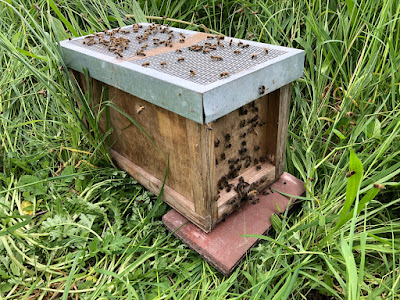April was cold, wet and just not good for beekeeping. So I had to wait through most of the month before I could actually check my hives for the first time. On the last Saturday, the weather was finally warm and dry enough to open up, so I headed over to the apiary, feeling cautiously excited to see what lay in store. Unfortunately, it was pretty bad news. Both hives and the nucleus looked like this:
That is, sadly, a cluster of dead bees. So, all three colonies have perished. What killed them? I can't say for sure - maybe it was a virus, maybe the cold and damp weather, perhaps a combination of the two, or something else entirely. Whatever the reason, this is sadly the end for queens Christina, Philippa and Henrietta. Unfortunately, there is only one thing to be done - all the brood frames have to be burned.
There is some honey in the hives. Some of it has started to ferment, and so won't be consumable. But some I think is still sealed and could well be extracted and put into jars. I'm going to have a look tomorrow and see what I can rescue. As for the honey that has started to ferment... I'm wondering if this is the year when I finally have a go at making mead? At least it will be something to cheer myself up after losing all my bees.
However... all is not lost. On Wednesday, I got a call from fellow local beekeeper Gerry, who saw this hanging from a tree opposite his house:
That is a swarm - a big one, too! Gerry already has his apiary fully stocked, so he was kind enough to offer me first dibs on the bees - and I of course jumped at the chance! Luckily, the swarm was on a nice flexible branch at head height, so Gerry held a large bucket underneath while I gave the the branch a quick shake, and the whole swarm dropped into the bucket. It was a textbook swarm collection. Gerry had a spare nucleus, so he tipped the bees in and put the roof on, and then we waited for them to settle.
After about an hour they had all settled down, and the remaining airborne bees had all made their way into the nucleus. So I placed them (carefully!) into the car, and drove the short distance up to the apiary, where I had some spare frames ready to pop inside. This was the point I realised just what a big swarm it was - it took some time to carefully slide the new frames in between the thousands of bees:
So that is where we are so far - all my old bees are gone, but I'm in a great position to get back started again this year. I'm planning to go to the apiary tomorrow, rescue what harvestable honey I can, and then move the bees into one of the hives. Once that's done, the new beekeeping year should be properly under way.




